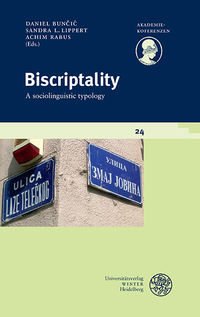
Biscriptality
A sociolinguistic typology
In Co-op. with:
Anastasia Antipova, Carmen Brandt, Ekaterina Kislova, Henning Klöter, Alexandra von Lieven, Sandra L. Lippert, Helma Pasch, Achim Rabus, Jürgen Spitzmüller, Constanze Weth
1. Edition, 2016
425 Pages
ISBN: 978-3-8253-7619-2
Product: Ebook
Edition: PDF
Subject: Slavistik
Series: Akademiekonferenzen, Volume No.: 24
Available: 09.06.2016
Keywords:
Deutsch, Russisch, Soziolinguistik, Schrift, Orthographie, Mittellatein, Typographie, Serbokroatisch, Schriftlinguistik, Zweischriftigkeit, Typologie (Linguistik), Belarussisch, Ägyptisch, Chinesisch, Hindu-Urdu
Serbs write their language in Cyrillic or Latin letters in seemingly random distribution. Hindi-Urdu is written in Nāgarī by Hindus and in the Arabic script by Muslims. In medieval Scandinavia the Latin alphabet, ink and parchment were used for texts ‘for eternity’, whereas ephemeral messages were carved into wood in runes. The Occitan language has two competing orthographies. German texts were set either in blackletter or in roman type between 1749 and 1941. In Ancient Egypt the distribution of hieroglyphs, hieratic and demotic was much more complex than commonly assumed. Chinese is written with traditional and simplified characters in different countries.
This collective monograph, which includes contributions from eleven specialists in different philological areas, for the first time develops a coherent typological model on the basis of sociolinguistic and graphematic criteria to describe and classify these and many other linguistic situations in which two or more writing systems are used simultaneously for one and the same language.
""
Ivana Eterović in: Slovo, 68 (2018), 323-327, URL: https://hrcak.srce.hr/218320
""
Sveva Elti di Rodeano in: Incontri Linguistici, 40 (2018), 188-190
""
Dieter Stern in: Kritikon Litterarum, 45.1-2 (2018), 72ff
""
Agnes Kim in: Journal of Historical Sociolinguistics, 3.2 (2017), 297ff
""
Nina B. Mečkovskaja in: Slověne, 6.2 (2017), 721f
""
Aleksandra Salamurović in: Acta Slavica Iaponica, XXXIX (2018), 113ff, http://hdl.handle.net/2115/84120
Inhalt (PDF 209kB)
► Zur Forschungsseite biscriptality.org
Zweischriftigkeit ist der gleichzeitige Gebrauch von zwei (oder mehr) Schriftsystemen (einschließlich unterschiedlicher Orthographien) für Varietäten ein und derselben Sprache. Diese Website stellt das zugrundeliegende soziolinguistische Konzept der Zweischriftigkeit, die Konferenz und die Monographie vor. Außerdem wird sie die weiteren Entwicklungen auf diesem Gebiet darstellen.




